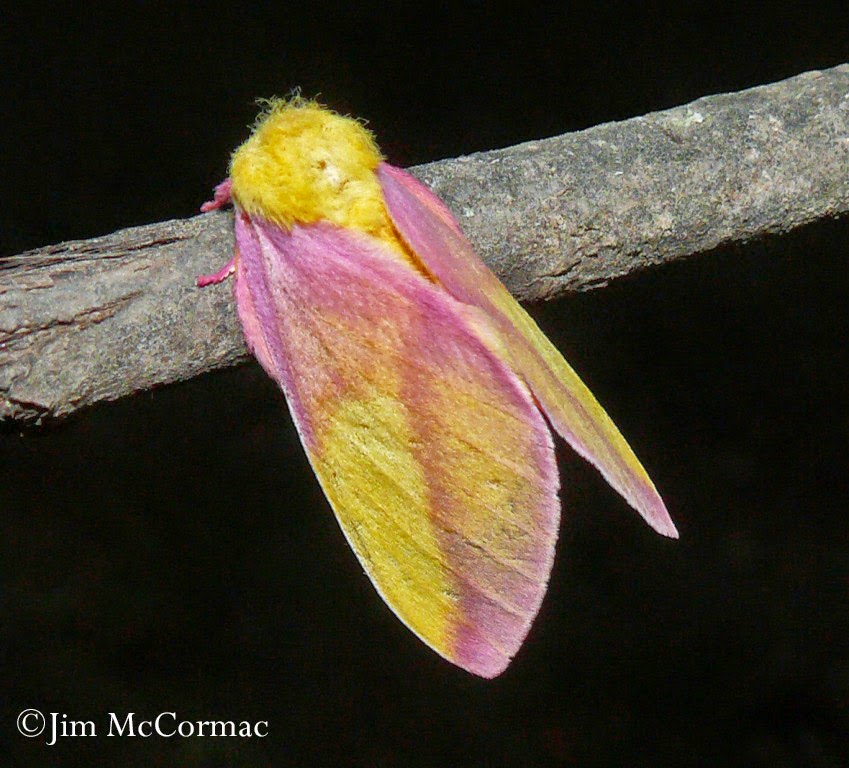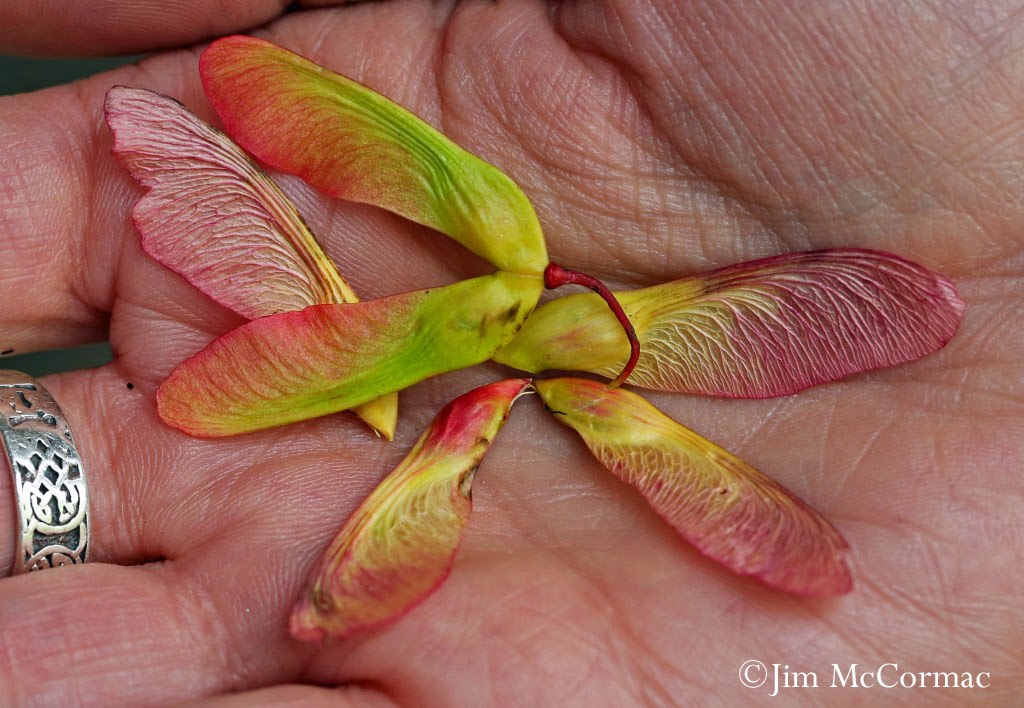A Rosy Maple Moth, Dryocampa rubicunda, glares menacingly at the camera. Well, it's looking as menacing as one can look when clad in hues of pink and yellow. These small silkworm moths are among the flashiest of the moths in eastern forests. They have been the "spark moth" for more than a few people, who, upon seeing one at a night light, become interested in the broader world of moths.
When at rest on an exposed twig or wall below a porch light, Rosy Maple Moths are utterly conspicuous. So much so that an observer is almost certain to wonder why it is so brightly colored.
The moth is well-named. Its primary host plants (the plants that its caterpillars must eat) are maples. Rosy Maple Moth caterpillars supposedly eat oak foliage, too, but it's definitely the maples that form the lion's share of the diet. The nut doesn't fall far from the tree, so to speak, and the adult moths will generally be found in close proximity to their maple hosts. Adult Rosy Maple Moths, by the way, do not eat. They are short-lived and exist only to find a member of the opposite sex, mate, and in the case of the female, drop eggs.
The showy little fruit dangling on pendant pedicels above are those of red maple, Acer rubrum, a common host plant of the Rosy Maple Moth. The maple fruit reach this stage in early spring, about the time that the hatch of moths commences.
A few weeks ago, Rachel Davis and I were leading a trip for the New River Birding & Nature Festival at Hawk's Nest State Park in West Virginia. Rachel had noticed a Rosy Maple Moth that was clinging to a wall under a nightlight - still present from the night before. We showed that to our group, and all were suitably awed by the festively colored moth. Then we noticed that the ground was littered with fresh red maple samaras (the term for the helicopter-like fruit of maples). The light bulb went off, and we began to harvest some of the more colorful fruit, as above.
Voila! We posed the Rosy Maple Moth on the fresh elm samaras, and suddenly its garish coloration made sense. I suspect that these moths ordinarily roost on hanging clusters of maple fruit during the day. In such a situation, the moth would nearly be invisible.
Nature is full of very cool adaptive camouflage, but this is perhaps one of the more interesting examples in our part of the world. At least, I think one could make a strong case that this explains the maple moth's showy coloration.
When at rest on an exposed twig or wall below a porch light, Rosy Maple Moths are utterly conspicuous. So much so that an observer is almost certain to wonder why it is so brightly colored.
The moth is well-named. Its primary host plants (the plants that its caterpillars must eat) are maples. Rosy Maple Moth caterpillars supposedly eat oak foliage, too, but it's definitely the maples that form the lion's share of the diet. The nut doesn't fall far from the tree, so to speak, and the adult moths will generally be found in close proximity to their maple hosts. Adult Rosy Maple Moths, by the way, do not eat. They are short-lived and exist only to find a member of the opposite sex, mate, and in the case of the female, drop eggs.
The showy little fruit dangling on pendant pedicels above are those of red maple, Acer rubrum, a common host plant of the Rosy Maple Moth. The maple fruit reach this stage in early spring, about the time that the hatch of moths commences.
A few weeks ago, Rachel Davis and I were leading a trip for the New River Birding & Nature Festival at Hawk's Nest State Park in West Virginia. Rachel had noticed a Rosy Maple Moth that was clinging to a wall under a nightlight - still present from the night before. We showed that to our group, and all were suitably awed by the festively colored moth. Then we noticed that the ground was littered with fresh red maple samaras (the term for the helicopter-like fruit of maples). The light bulb went off, and we began to harvest some of the more colorful fruit, as above.
Voila! We posed the Rosy Maple Moth on the fresh elm samaras, and suddenly its garish coloration made sense. I suspect that these moths ordinarily roost on hanging clusters of maple fruit during the day. In such a situation, the moth would nearly be invisible.
Nature is full of very cool adaptive camouflage, but this is perhaps one of the more interesting examples in our part of the world. At least, I think one could make a strong case that this explains the maple moth's showy coloration.


.jpg)

